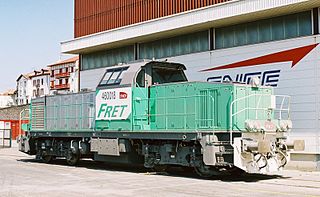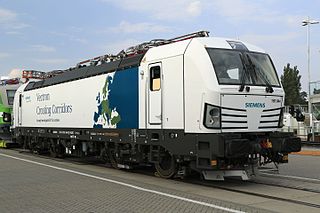
A locomotive or engine is a rail transport vehicle that provides the motive power for a train. If a locomotive is capable of carrying a payload, it is usually rather referred to as a multiple unit, motor coach, railcar or power car; the use of these self-propelled vehicles is increasingly common for passenger trains, but rare for freight trains.

An electric locomotive is a locomotive powered by electricity from overhead lines, a third rail or on-board energy storage such as a battery or a supercapacitor. Locomotives with on-board fuelled prime movers, such as diesel engines or gas turbines, are classed as diesel-electric or gas turbine-electric and not as electric locomotives, because the electric generator/motor combination serves only as a power transmission system.
The UIC classification of locomotive axle arrangements, sometimes known as the German classification or German system, describes the wheel arrangement of locomotives, multiple units and trams. It is used in much of the world, notable exceptions being the United Kingdom, which uses a slightly simplified form of UIC, and in North America, where the AAR wheel arrangement system is used to describe diesel and electric locomotives. In North America, the Whyte notation is only used for steam locomotives.
B-B and Bo-Bo are the Association of American Railroads (AAR) and British classifications of wheel arrangement for railway locomotives with four axles in two individual bogies. They are equivalent to the B′B′ and Bo′Bo′ classifications in the UIC system. The arrangement of two, two-axled, bogies is a common wheel arrangement for modern electric and diesel locomotives.

NSB Di 6, later designated ME 26 and DE 2700, is a class of twelve diesel-electric locomotives built by Siemens for the Norwegian State Railways (NSB). The prime mover provides a power output of 2,650 kilowatts (3,550 hp), a starting traction effort of 400 kilonewtons (90,000 lbf) and a maximum speed of 160 kilometres per hour (99 mph). They have a Co′Co′ wheel arrangement. The bidirectional locomotives were designed for use with both passenger and freight trains.

Alstom Traxx is a modular product platform of mainline diesel-electric and electric locomotives. It was produced originally by Bombardier Transportation and later Alstom, and was built in both freight and passenger variants. The first version was a dual-voltage AC locomotive built for German railways from the year 2000. Later types included DC versions, as well as quadruple-voltage machines, able to operate on most European electrification schemes: 1.5/3.0 kV DC and 15/25 kV AC. The family was expanded in 2006 to include diesel-powered versions. Elements common to all variants include steel bodyshells, two bogies with two powered axles each, three-phase asynchronous induction motors, cooling exhausts on the roof edges, and wheel disc brakes.

The Indian locomotive class WDP-4 is a passenger-hauling diesel-electric locomotive with AC electric transmission designed by General Motors Electro-Motive Division and built by both GM-EMD and under license by Banaras Locomotive Works (BLW) of Varanasi, India for Indian Railways as the classes WDP4, WDP4B and WDP4D. The GT46PAC is a passenger version of the previous Indian Railways EMD GT46MAC freight locomotive. The locomotive has a 16-cylinder 710G3B diesel engine and is one of the fastest diesel-electric locomotives in service in Indian Railways.

The SNCF Class BB 60000 are a class of 4 axle heavy shunting and light freight diesel–electric locomotives built at the Vossloh España works in Valencia. Since the class is primarily used as a freight locomotive the class is commonly referred to as SNCF BB 460000.

The NMBS/SNCB Class 77 is a class of 4 axle B'B' road switcher diesel hydraulic locomotive designed for shunting and freight work manufactured at the beginning of the 2000s by Vossloh Schienentechnik/Vossloh Locomotives at the Maschinenbau Kiel plant in Kiel, Germany for the National Railway Company of Belgium (SNCB/NMBS).

The EuroSprinter family of electric locomotives is a modular concept of locomotives for the European market built by Siemens Mobility. The internal Siemens product name is ES 64, with ES for EuroSprinter and the number 64 indicating the 6,400 kW power at rail.

Railjet is a high-speed rail service in Europe operated by Austrian Federal Railways (ÖBB) and Czech Railways (ČD). Branded as Railjet Express (RJX) for the fastest services and as Railjet (RJ) for services with additional stops, it was introduced in 2008 and operates at speeds of up to 230 km/h (143 mph). Railjet is ÖBB's premier service and operates both domestically within Austria and on international services to adjacent major cities in the Czech Republic, Germany, Switzerland, Italy, Hungary and Slovakia.

The Voith Maxima locomotives are a family of diesel-hydraulic locomotives built by Voith Turbo Lokomotivtechnik GmbH & Co. KG., a subsidiary of Voith.

The Stadler Euro is a class of diesel-electric locomotives built by Stadler Rail for the European market. It is available in two basic variants, the four-axle Euro 3000, and the six-axle Euro 4000. These locomotives are powered by EMD 710 prime movers. A six-axle electric-only variant is marketed as Euro 6000; it is also built for the Iberian gauge.

The Prima Diesel-electric locomotives are a class of medium and heavy, four- and six-axle, passenger and freight mainline locomotives. They have been built both to 1,435 mm standard and 1,668 mm broad gauges, and find use in the Middle East, Europe and North America. Alstom is the primary designer in cooperation with both General Motors and Siemens.

The SNCF BB 75000 are 4 axle, Bo′Bo′, diesel electric locomotives ordered in 2000 by SNCF for freight operations to renew its aging fleet.

The Vectron is a locomotive series made by Siemens Mobility, introduced at the 2010 InnoTrans trade fair in four prototype versions: diesel, multi-system, and both AC and DC electric power. The diesel version has been replaced in 2018 by a dual mode locomotive which is powered by electricity on electrified sections of the track and can be switched to diesel mode on non-electrified sections. The Vectron series is reconfigurable and modular, with a Bo'Bo' wheel arrangement, and is intended as the successor to the EuroSprinter family of locomotives. A more affordable, basic version called Smartron was introduced in 2018.

The ÖBB 2070 is a class of 90 shunting and light multipurpose four axle B'B' Diesel-hydraulic locomotive built for the Austrian Federal Railways by Vossloh at the MaK locomotive plant in Kiel, Germany.

The Stadler Eurolight is the brand name for a family of 4-axle Bo'Bo' mainline diesel-electric locomotives with sub-20-tonne axleloads for passenger and freight trains produced by Stadler Rail.

The Stadler Euro Dual is a series of dual power, electro-diesel locomotive by Stadler Rail Valencia. Unlike traditional dual mode locomotives, fitted with relatively low-powered diesel engines for 'last mile' movements only, vehicles are typically furnished with power units more comparable to that of mainline diesel locomotives.

Rigid-framed electric locomotives were some of the first generations of electric locomotive design. When these began the traction motors of these early locomotives, particularly with AC motors, were too large and heavy to be mounted directly to the axles and so were carried on the frame. One of the initial simplest wheel arrangements for a mainline electric locomotive, from around 1900, was the 1′C1′ arrangement, in UIC classification.




























